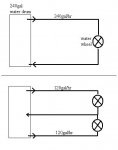Don't read too much into it.Your hexaphase drawing does not have all the windings going the same way (I mean like clockwise) as looking out from the neutral. I believe you drew it that way to show some sort of relationship between hexaphase and single phase.
The drawing does not show winding direction.
I mirror imaged some of the legs to avoid clutter, nothing more.
The phase relationships I gave are the import issue.


